Climate Change Mitigation Pathways for Southeast Asia: CO2 Emissions Reduction Policies for the Energy and Transport Sectors
Abstract
:1. Introduction
2. Materials and Methods
3. Results
3.1. Indonesia
3.1.1. NDC Summary and Targets
3.1.2. NDC Main Policies
3.1.3. Other National Policies and Plans
- The Smart Street Lighting Initiative [12] aims to increase the energy efficiency of street lighting by substituting conventional street lighting with more efficient technologies in Indonesian cities and urban areas. Considering the current average lifetime (10 years) of LED street lighting technologies, the initiative can achieve up to approximately 1.4 MtCO2e in 2024.
- Sustainable Urban Transport Initiative [13] comprises sustainable transport policies that include a tailor-made mix of “push” and “pull” measures for each city, including high quality public transport, non-motorized transport, parking management, traffic management, spatial planning, alternative fuels and vehicle efficiency. The estimated GHG reduction is 5 MtCO2e in eight years.
3.2. Malaysia
3.2.1. NDC Summary and Targets
3.2.2. NDC Main Policies
- National Biofuel Policy (2006)
- National Energy Policy (2008)
- National Green Technology Policy (2009)
- National Policy on Climate Change (2009)
- Low Carbon Cities Framework (2011)
- National Automotive Policy (2014).
3.2.3. Other Background Information
3.3. Philippines NDC
3.3.1. NDC Summary and Targets
3.3.2. NDC Main Policies
3.3.3. Other National Policies and Plans
3.4. Singapore
3.4.1. NDC Summary and Targets
3.4.2. NDC Main Policies
3.4.3. Other National Policies and Plans
3.5. Thailand
3.5.1. NDC Summary and Targets
3.5.2. NDC Main Policies
3.5.3. Other National Policies and Plans
3.6. Vietnam
3.6.1. NDC Summary and Targets
3.6.2. NDC Main Policies
- National Target Program to Respond to Climate Change (2009–2015)
- National Socio-economic Development Strategy (2011–2020)
- Socio-economic Development Plan (2011–2015)
- Law on Environment (6/2014)
- Law on Economical and Efficient use of Energy (6/2010).
3.6.3. Other National Policies and Plan
4. Discussion
- Most countries are expected to see rapid growth in energy-related CO2 emissions between 2010 and 2030 in a business as usual (BAU) projection, i.e., with no policy action. This ranges from more than a doubling (e.g., Indonesia, Philippines and Vietnam), to relatively small increases (Singapore).
- The targeted reductions vary in terms of the size of the range of targets (which relate to various conditionalities put on achieving the targets, and/or an actual indicated range of targets), the position of this range relative to the BAU emissions in 2030 (and extent of reductions compared to 2030), and the position relative to 2010 emissions. Some countries (such as Indonesia and the Philippines) have targets that extend well below 2030 levels and even, in the case of the Philippines, reach their 2010 levels. Other countries have little or no reductions relative to the projected 2030 emissions.
- On a per-capita basis, the relative position of the bars is similar, but substantial differences in today’s and projected future emissions per person become evident. Some countries (Indonesia, Philippines, Vietnam) had very low per-capita emissions in 2010, while others had significantly higher per-capita emissions. Targeted emissions in 2030 also vary considerably per capita, with the Philippines being notable for a very low per-capita target.
- On a per-GDP basis (carbon intensity of economic output), variations are again quite significant, but the relative positions of different countries change considerably from a per-capita view. Singapore, with the highest 2010 per-capita emissions, and the lowest emissions per unit GDP.
5. Conclusions
Acknowledgments
Author Contributions
Conflicts of Interest
References
- United Nations Framework Convention on Climate Change. UNFCCC Synthesis Report on the Aggregate Effect of Intended Nationally Determined Contributions. 2016. Available online: http://unfccc.int/resource/docs/2016/cop22/eng/02.pdf (accessed on 27 June 2017).
- Zhang, W.; Pan, X. Study on the demand of climate finance for developing countries based on submitted INDC. Adv. Clim. Chang. Res. 2016, 7, 99–104. [Google Scholar] [CrossRef]
- Fujimori, S.; Su, X.; Liu, J.Y.; Hasegawa, T.; Takahashi, K.; Masui, T.; Takimi, M. Implication of Paris Agreement in the context of long-term climate mitigation goals. SpringerPlus 2016, 5. [Google Scholar] [CrossRef]
- Lah, O. Continuity and Change: Dealing with Political Volatility to Advance Climate Change Mitigation Strategies—Examples from the Transport Sector. Sustainability 2017, 9, 959. [Google Scholar] [CrossRef]
- CAIT Climate Data Explorer. Available online: http://cait.wri.org (accessed on 14 December 2016).
- United Nations Framework Convention on Climate Change. INDCs as Communicated by Parties. Available online: http://www4.unfccc.int/submissions/indc/Submission%20Pages/submissions.aspx (accessed on 14 December 2016).
- Asia Pacific Economic Cooperation. APEC Energy Demand and Supply Outlook, 6th ed.; Asia Pacific Energy Research Centre (APERC): Tokyo, Japan, 2016. [Google Scholar]
- Climate and Development Knowledge Network (CDKN). Indonesian Feed-In Tariffs: Challenges & Options. Available online: http://cdkn.org/wp-content/uploads/2015/04/ECN-Policy-Brief-Indonesian-Feed-in-tariff-140304.pdf (accessed on 14 December 2016).
- Climata Action Tracker (CAT). Rapid Phase out of Coal Essential, but Not Enough to Hold Warming below 2 °C. 2014. Available online: http://climateactiontracker.org/assets/publications/briefing_papers/CAT_BKM_2014.09.22_PRESS_DISTRIBUTION_final.pdf (accessed on 27 June 2017).
- International Energy Agency. Policies & Measures Databases. Biofuel Blending (Ministry Regulation No. 25/2013). Available online: https://www.iea.org/policiesandmeasures/pams/indonesia/name-140193-en.php (accessed on 27 June 2017).
- International Energy Agency. Policies & Measures Databases. Transport Ministerial Regulation No. 201/2013. Available online: https://www.iea.org/policiesandmeasures/pams/indonesia/name-140152-en.php (accessed on 27 June 2017).
- United Nations Framework Convention on Climate Change. NS-89—Smart Street Lighting Initiative. Available online: http://www4.unfccc.int/sites/nama/_layouts/un/fccc/nama/NamaSeekingSupportForImplementation.aspx?ID=55&viewOnly=1 (accessed on 14 December 2016).
- United Nations Framework Convention on Climate Change. UNFCCC Public NAMA. NS-65—Sustainable Urban Transport Initiative. Available online: http://www4.unfccc.int/sites/nama/_layouts/un/fccc/nama/NamaSeekingSupportForImplementation.aspx?ID=43&viewOnly=1 (accessed on 27 June 2017).
- Ministry of Plantation Industries and Commodities Malaysia. National Biofuel Policy. Available online: http://www.e-kilangmpob.com.my/biodiesel/document/Malaysia%20Biofuel%20Policy.pdf (accessed on 14 December 2016).
- News Straits Times Press. Fuel Prices Go Up in October. Available online: http://www.nst.com.my/news/2016/09/177225/fuel-prices-go-october (accessed on 14 December 2016).
- Sustainable Energy Development Authority Malaysia. National Renewable Energy Policy and Action Plan (2009). Available online: http://www.seda.gov.my/?omaneg=00010100000001010101000100001000000000000000000000&s=31 (accessed on 14 December 2016).
- Lopez, G.; Laan, T. Biofuels—At what cost? Government Support for Biodiesel in Malaysia; International Institute for Sustainable Development: Geneva, Switzerland, 2008; Available online: https://www.iisd.org/gsi/sites/default/files/Final_Malaysia_2.pdf (accessed on 27 June 2017).
- National Climate Change Action Plan 2011–2028. Available online: http://faolex.fao.org/docs/pdf/phi152934.pdf (accessed on 14 December 2016).
- Department of Energy Republic of Philippines. National Renewable Energy Program (NREP). Available online: https://www.doe.gov.ph/national-renewable-energy-program (accessed on 14 December 2016).
- Department of Energy Republic of Philippines. Philippines Energy Plan 2012–2030. Available online: https://www.doe.gov.ph/sites/default/files/pdf/pep/2012–2030_pep.pdf (accessed on 14 December 2016).
- National Environmentally Sustainable Transport (EST) Strategy for the Philippines. Available online: http://www.uncrd.or.jp/index.php?page=view&type=13&nr=21&menu=232 (accessed on 14 December 2016).
- Hao, H.; Liu, Z.; Zhao, F.; Li, W. Natural gas as vehicle fuel in China: A review. Renew. Sustain. Energy Rev. 2016, 62, 521–533. [Google Scholar] [CrossRef]
- United Nations Framework Convention on Climate Change. UNFCCC Public NAMA. NS-246—People-Centred Urban Mobility in Thailand (Thailand Mobility NAMA). Available online: http://www4.unfccc.int/sites/nama/_layouts/un/fccc/nama/NamaSeekingSupportForImplementation.aspx?ID=167&viewOnly=1 (accessed on 14 December 2016).
- Vietnam’s Socio-Economic Development Strategy for the Period of 2011–2020. Available online: http://www.economica.vn/portals/0/maubieu/1d3f7ee0400e42152bdcaa439bf62686.pdf (accessed on 14 December 2016).


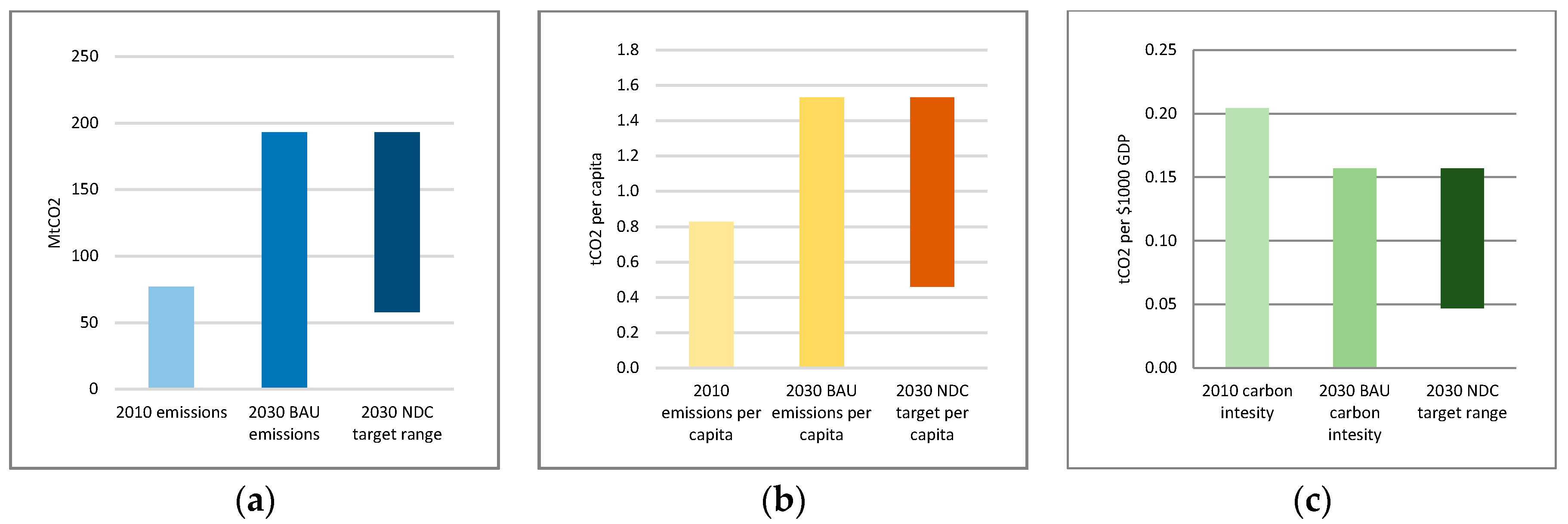
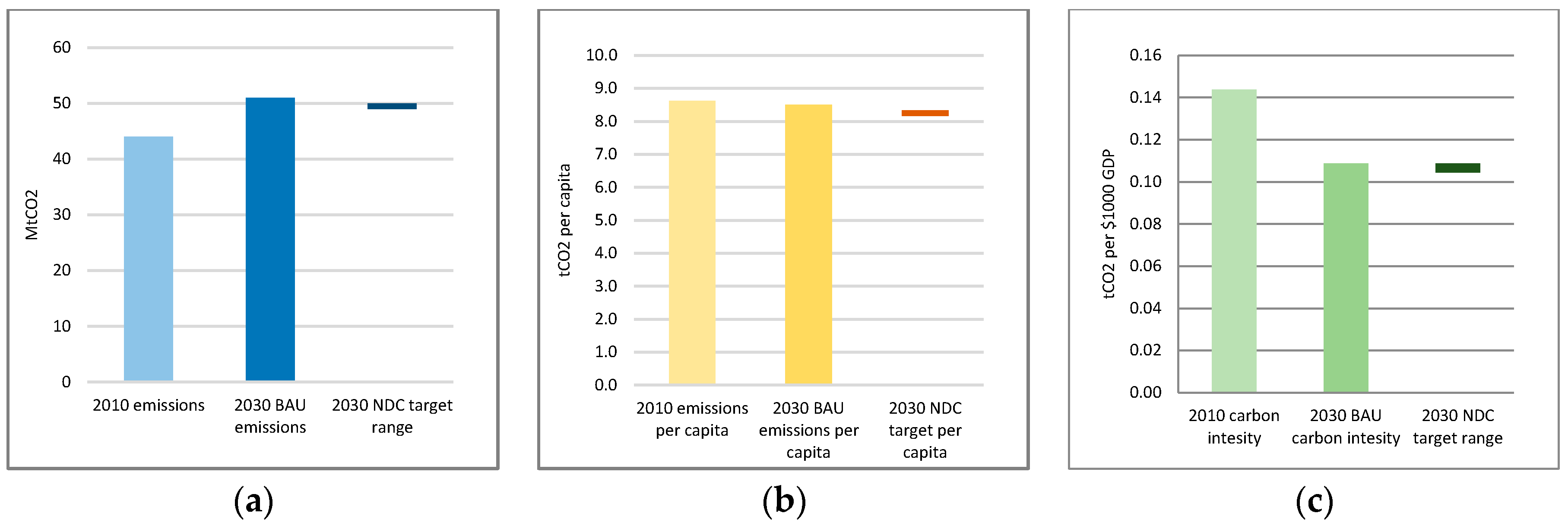


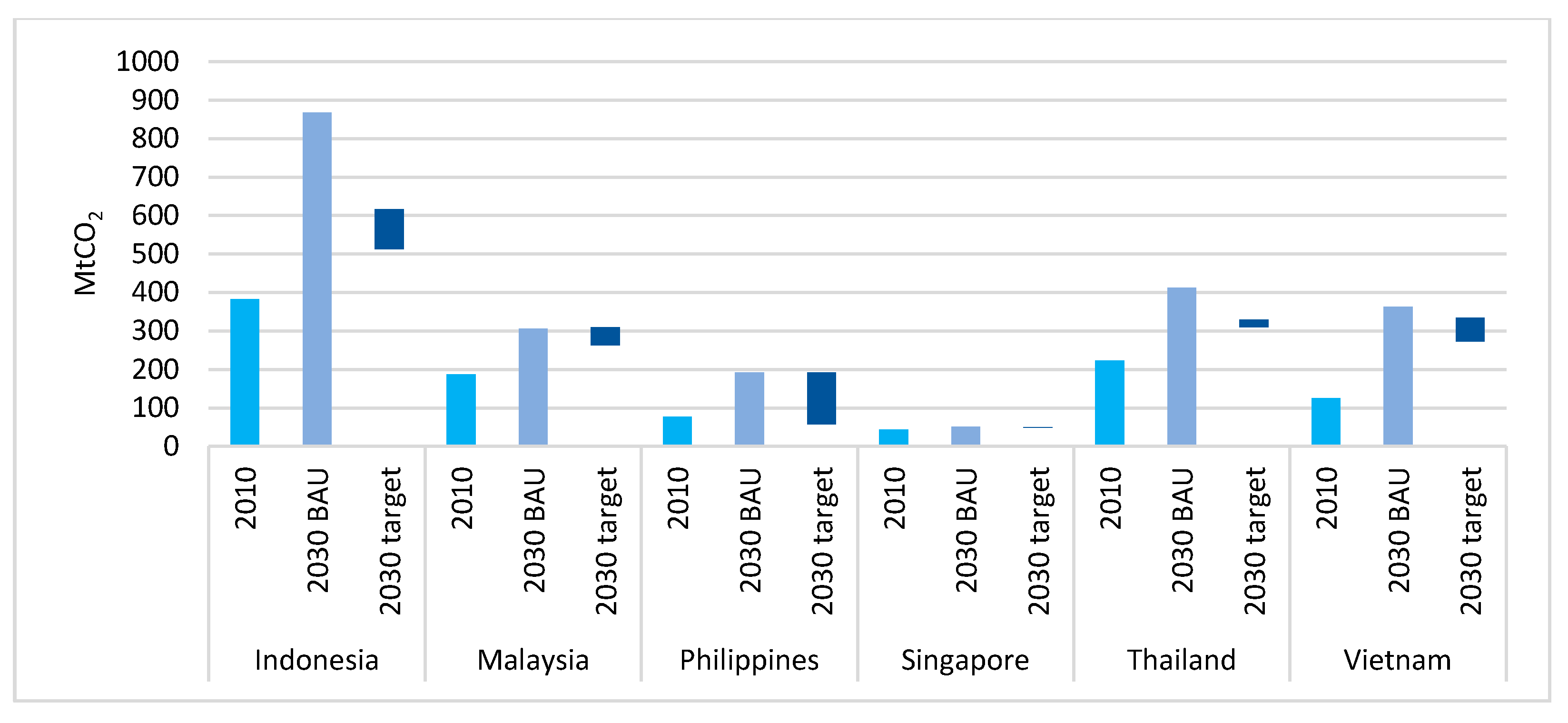
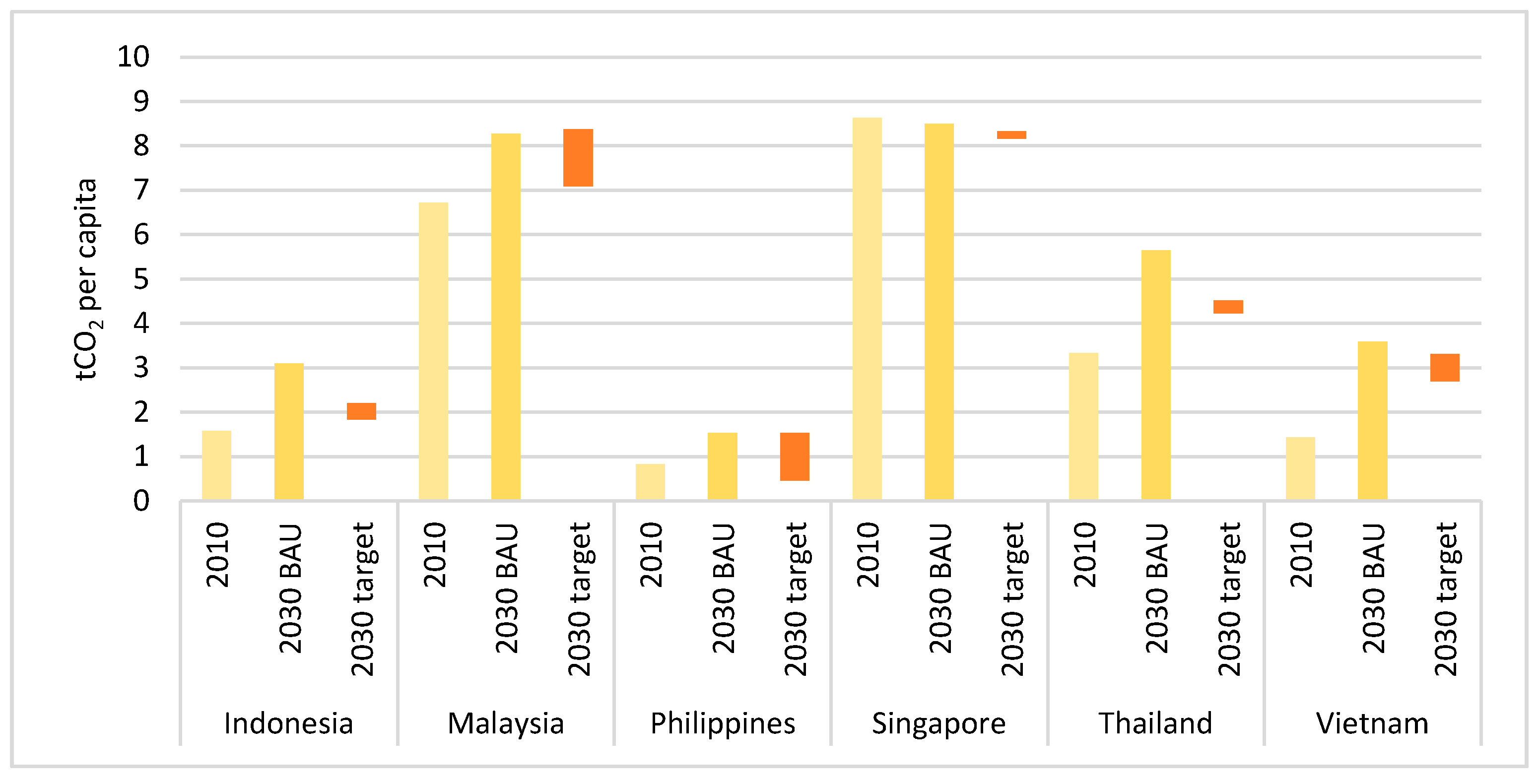
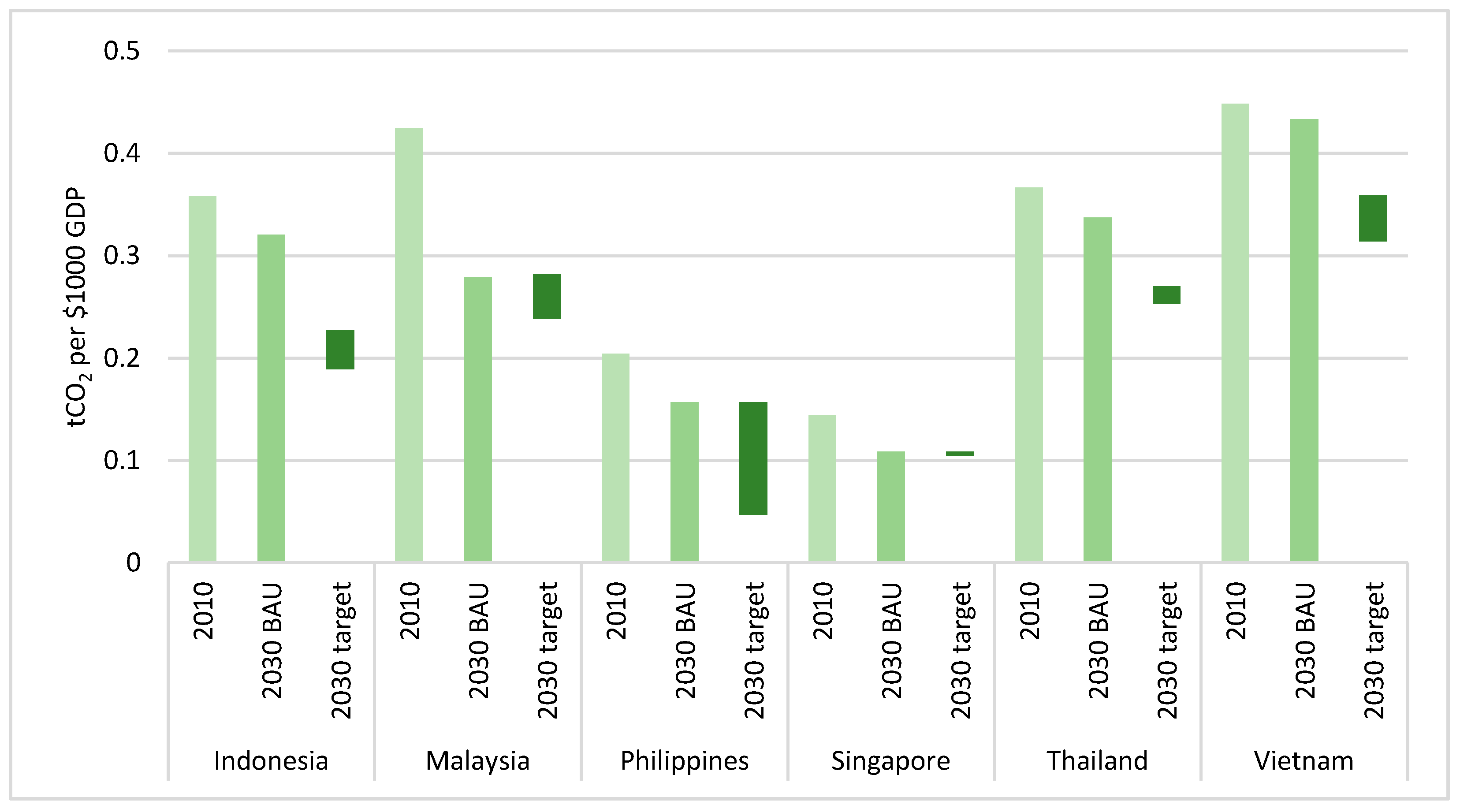
| Country | INDC Ratified | Energy Related Emissions (%) (2010) | Targets (Unconditional-Conditional) | Type of Target and Against What? | Key Targets and Quantified Policies to Achieve Target | Main Policies Related to Energy Cited in the INDC |
|---|---|---|---|---|---|---|
| Indonesia | Yes | 20% | 29–41% | Absolute BAU 2030 | Increase of renewable energy to 23% of primary energy supply by 2025 | National Energy Policy, National Action Plan for Greenhouse Gas Emission Reduction, National Medium Term Development Plan 2015–2019,National Team for Biofuel Development and Biofuel Roadmap, Transport Ministerial Regulation No. 201 |
| Major increases in biofuel blending in transport and electric sector | ||||||
| Sustainable urban transport initiative with avoid/shift/improve aspects | ||||||
| Malaysia | Yes | 58% | 35–45% | GHG intensity per GDP against 2005 levels (0.531 tons CO2e per thousand RM) | Biodiesel blending targets | National Biofuel Policy 2006, National Renewable Energy Policy and Action Plan, Eleventh Malaysia Plan 2016–2020, National Renewable Energy Policy and Action Plan, National Biofuel Policy 2006 |
| Removal of energy subsidies | ||||||
| Renewables to reach 11% of electricity generation by 2030 | ||||||
| Investments in rapid transit | ||||||
| Increase in natural gas vehicles | ||||||
| Philippines | No | 51% | 70% (conditional) | Absolute BAU 2030 | 10% energy savings on total annual energy demand of all economic sectors by 2030 | National Climate Change Action Plan 2011–2028, National Renewable Energy Program, Biofuels Act of 2006, Renewable Energy Act of 2008, Philippine Energy Plan, National Environmentally Sustainable Transport Strategy 2010–2020, National Energy Efficiency and Conservation Program |
| 30% of all public utility vehicles running on alternative fuels nationwide by 2030 | ||||||
| Natural gas as a major alternative fuel for public transport; and addition of CNG refilling stations and LNG hub terminals | ||||||
| Singapore | Yes | 77% | 36% (general) | Emissions intensity reduction against 2005 levels (0.176 kgCO2e/S$ in 2005, 0.113 kgCO2e/S$ in 2030), and total emissions to peak by 2030 | Renewable energy to reach 8% of peak electricity demand by 2030 | Energy Conservation Act, Grant for Energy Efficient Technologies (GREET), Energy Efficiency Improvement Assistance Scheme (EASe), Building Control Act, Mandatory Energy Labelling Scheme (MELS) |
| Achieve “greening” of 80% of buildings by 2030 | ||||||
| Length of rail network to be doubled by 2030 | ||||||
| Vehicle and road taxes ongoing; CO2 based as of 2013 | ||||||
| Thailand | Yes | 53% | 20–25% | Absolute BAU 2030 | Increase to 30% renewable share of energy consumption in 2036 | Climate Change Master Plan 2015–2050, Energy Efficiency Plan 2015–2036, Alternative Energy Development Plan 2015–2036, Environmentally Sustainable Transport System Plan 2013–2030 |
| Reduce the country’s energy intensity by 30% below the 2010 level in 2036 | ||||||
| Master plan targets 7–20% reduction of GHG emission from energy and transport sector by 2020 relative to BAU. | ||||||
| Major improvements to transit systems and urban infrastructure to encourage modal shift to transit | ||||||
| Vietnam | Yes | 41% | 8–25% | Absolute BAU 2030; subgoals Emission intensity per unit of GDP will be reduced by 20–30% compared to the 2010 levels | Annual energy consumption decreases at 2.5–3% of GDP. | National Green Growth Strategy, National Climate Change Strategy, National Socio-economic Development Strategy, Renewable Energy Development Strategy 2016–2030 |
| 90% of industrial production facilities use cleaner technologies and save energies, fuels, and materials by 2020 | ||||||
| 20% of buses and taxis use CNG and LPG by 2020 and 80% by 2050 |
© 2017 by the authors. Licensee MDPI, Basel, Switzerland. This article is an open access article distributed under the terms and conditions of the Creative Commons Attribution (CC BY) license (http://creativecommons.org/licenses/by/4.0/).
Share and Cite
Fulton, L.; Mejia, A.; Arioli, M.; Dematera, K.; Lah, O. Climate Change Mitigation Pathways for Southeast Asia: CO2 Emissions Reduction Policies for the Energy and Transport Sectors. Sustainability 2017, 9, 1160. https://doi.org/10.3390/su9071160
Fulton L, Mejia A, Arioli M, Dematera K, Lah O. Climate Change Mitigation Pathways for Southeast Asia: CO2 Emissions Reduction Policies for the Energy and Transport Sectors. Sustainability. 2017; 9(7):1160. https://doi.org/10.3390/su9071160
Chicago/Turabian StyleFulton, Lew, Alvin Mejia, Magdala Arioli, Kathleen Dematera, and Oliver Lah. 2017. "Climate Change Mitigation Pathways for Southeast Asia: CO2 Emissions Reduction Policies for the Energy and Transport Sectors" Sustainability 9, no. 7: 1160. https://doi.org/10.3390/su9071160




